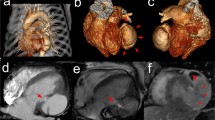Abstract
Left ventricular pseudoaneurysm is a rare, but potentially fatal, condition that generally occurs as a complication of myocardial infarction, infective endocarditis, or cardiac surgery. Surgical repair is the treatment of first choice because of the marked risk of rupture, but deteriorated hemodynamics and complicated procedures to treat the pseudoaneurysm may lead to a high mortality rate. We report a 62-year-old woman with a large left ventricular pseudoaneurysm after mitral valve replacement for rheumatic mitral valve stenosis. Surgical repair was not performed due to the patient’s refusal, but her pseudoaneurysm resolved spontaneously by 2 years after mitral valve replacement. Spontaneous obliteration of a large left ventricular pseudoaneurysm is very rare in a patient on warfarin therapy. This case suggests that a left ventricular pseudoaneurysm with a narrow neck may resolve spontaneously in rare settings.


Similar content being viewed by others
References
Frances C, Romero A, Grady D. Left ventricular pseudoaneurysm. J Am Coll Cardiol. 1998;32:557–61.
Pretre R, Linka A, Jenni R, Turina MI. Surgical treatment of acquired left ventricular pseudoaneurysms. Ann Thorac Surg. 2000;70:553–7.
Cheng LC, Chiu CSW, Lee JWT. Left ventricular rupture after mitral valve replacement. J Cardiovasc Surg. 1999;40:339–42.
Treasure RL, Rainer WG, Strevey TE, Salder TR. Intraoperative left ventricular rupture associated with mitral valve replacement. Chest. 1974;66:511–4.
Miller DW, Johnson DD, Ivey TD. Dose prevention of the posterior chordae tendineae enhance survival during mitral valve replacement? Ann Thorac Surg. 1979;28:22–7.
Sakai K, Nakamura K, Ishizuka N, Nakagawa M, Hosoda S. Echocardiographic findings and clinical features of left ventricular pseudoaneurysm after mitral valve replacement. Am Heart J. 1992;124:975–82.
Yeo TC, Malouf JF, Oh JK, Seward JB. Clinical profile and outcome in 52 patients with cardiac pseudoaneurysm. Ann Intern Med. 1998;128:299–305.
Tai YT, Mok CK, Chow WH. Left ventricular pseudoaneurysm after replacement of the mitral valve: long-term survival and spontaneous closure. Int J Cardiol. 1989;25:349–51.
Conflict of interest
All the authors have declared no conflict of interest associated with this manuscript.
Author information
Authors and Affiliations
Corresponding author
Rights and permissions
About this article
Cite this article
Inoue, T., Hashimoto, K., Sakamoto, Y. et al. Spontaneous closure of a large left ventricular pseudoaneurysm after mitral valve replacement. Gen Thorac Cardiovasc Surg 64, 337–339 (2016). https://doi.org/10.1007/s11748-014-0474-y
Received:
Accepted:
Published:
Issue Date:
DOI: https://doi.org/10.1007/s11748-014-0474-y




